Sculpture... dining: the table triumph of Damià Campeny
From the very first moment one enters the Salone Maria Luigia of the National Gallery of Parma, one cannot help but notice what occupies the exact center of the large room that houses, on its walls, the ancient academic essays of the city’s Academy of Fine Arts: a sumptuous table triumph.
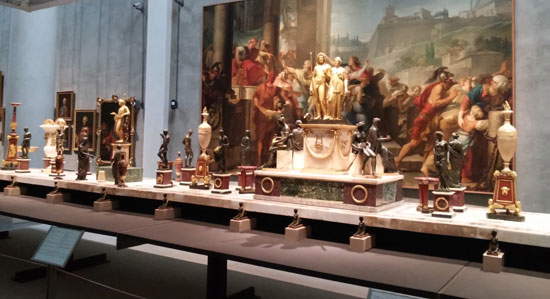 |
| Damià Campeny, Table Triumph (1803-1806; Parma, National Gallery) |
What, meanwhile, is a table triumph? It was, quite simply, compositions of ornaments, which could take the form of statues or elements of architecture, and which were arranged in the center of a dining table to adorn it during important receptions, perhaps even with the intention of surprising the guest: the refinement of such compositions and the fine materials with which the objects were made made made them, as one might naturally imagine, peculiar to the dining rooms of the wealthy classes. Already during the Renaissance it was quite common to decorate the center of the dining table, but as time went on, table triumphs began to have more and more complex patterns, culminating in large structures such as the one that characterizes the Parma triumph. They often had a practical function as well: they were used to hold food (especially fruit) or to hold beverages, as there was sometimes no shortage of vases and vessels in such triumphs. And, of course, table triumphs followed not only the personal inclinations of the patrons but also the artistic tastes of the times in which they were made: the triumph we can admire in the Salone Maria Luigia, made between 1803 and 1806, is in fact in the neoclassical style.
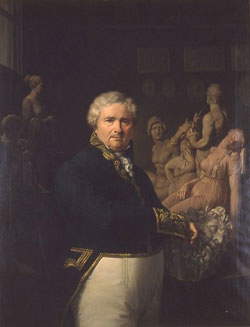 |
| Vicenç Rodés, Portrait of Damià Campeny (ca. 1838; Barcelona, Reial Acadèmia Catalana de Belles Arts de Sant Jordi) |
However, the story of the luxurious composition has some obscure points: in fact, we do not know exactly how it arrived in Parma. We do know, however, who commissioned it: it was the Spanish ambassador to the Papal States, Antonio de Vargas y Laguna, who entrusted the task of making the triumph to the Catalan sculptor Damià Campeny (1771 - 1855), who worked in Rome between 1797 and 1815. The finished work exhibited today in Parma allows us to imagine it as it was when it was displayed during official receptions at the headquarters of the Spanish Embassy in Rome: it could indeed adorn a table of seventy covers, but Campeny had devised a composition that could be adapted even if the banquet participants were fewer in number.
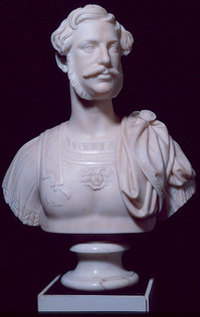 |
| William Theed, Portrait of Charles II of Parma (1840; Parma, Galleria Nazionale) |
We were saying that we are not clear about how Damià Campeny’s triumph came to Parma. Presumably, he became part of the heredity of the King of Spain, Charles IV of Bourbon whose son-in-law, Ludovico di Borbone-Parma, was the son of the Duke of Parma, Ferdinand I, who ruled the fortunes of Parma and Piacenza between 1765 and 1801. When Napoleon conquered the Duchy of Parma and Piacenza in 1800, he decided to compensate the Bourbons of Parma by awarding Ludovico, in 1801, the crown of the ephemeral kingdom of Etruria, established that year by Napoleon himself. However, for the Bourbons there was still no peace: Ludovico would die, overcome by ill health, only two years later, barely 30 years old, and his wife Maria Luisa, daughter of Charles IV, would become regent of the state. To mar the family’s tranquility once again would intervene Napoleon, who in 1807 removed Maria Luisa from all her duties at the court of Etruria: she, along with her two children Carlo Ludovico and Maria Luisa Carlotta, had to seek refuge in Spain. The Bourbons of Parma were only allowed to return to Italy after the Restoration: however, they were granted the Duchy of Lucca, because that of Parma had been assigned to Napoleon’s wife, Marie Louise of Habsburg. Only following the latter’s death were the Bourbons, with Charles Ludovico (who became Charles II of Parma for the occasion) allowed to return to rule the duchy of Emilia.
We have told this brief history of the vicissitudes of the Bourbons of Parma in the early nineteenth century because of the fact that, in all likelihood, Damià Campeny’s table triumph had to follow the family: Charles II had lived his adolescence in Rome, under the tutelage of his grandfather Charles IV of Spain, and it is therefore likely that he received the triumph as an inheritance when the king passed away in 1819. It is therefore conceivable that in 1824, when he succeeded his mother Maria Luisa as duke of Lucca, he took the furniture with him to Tuscany, and then again sent it to Emilia when he became duke of Parma and Piacenza. What is certain is that the composition is first attested in Parma in 1861, in an inventory of the possessions of the former dukes of Parma in the Palazzo della Pilotta, drawn up following the Unification of Italy. It finally arrived in the Gallery in 1865, when the Academy of Fine Arts obtained permission from the Savoy to move it.
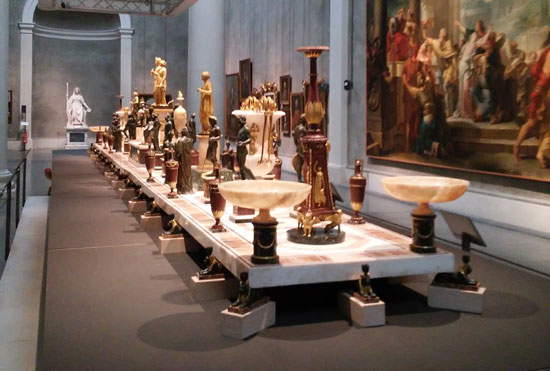 |
| View from the back of the Salone |
However, the Table Triumph was always hidden from the view of visitors to the Gallery because of its fragility: it was restored in the late 1990s, however, and the public has been able to admire it for the first time since 1999, when the National Gallery of Parma exhibited it in its current location, attempting to recreate what might have been the original setting, in an exhibition dedicated precisely to Damià Campeny’s masterpiece.
As can easily be seen by observing it, the triumph is a very complex piece of furniture: about eighty pieces, if we also include the thirty-two lions that support the base, all made of marble of various colors (for the bases), bronze sometimes gilded (the statues) and alabaster (some of the surrounding objects). As anticipated, the work reflects the neoclassical taste of the time with statues distinguished by elegant and imperturbable poses, and lusty and harmonious bodies. The complex iconographic program underlying the triumph is inspired by Cesare Ripa ’s famous treatise on iconology and, trivializing, we can say that it represents the cycle of the seasons. At the center of the composition stand the statues of Apollo and Diana, symbolizing the sun and moon respectively. The four female figures seated around them, on the other hand, represent the four natural elements (water, air, earth and fire), each represented by a different object that unmistakably refers to the element. On its two tall bases, equidistant from the figures of Apollo and Diana and at the end of the composition, we find, on either side, statues depicting the gods Ceres and Bacchus, respectively goddess of the earth, responsible for the cycle of the seasons, and god of wine. Around them we see statues depicting offerers in the act of bearing gifts to the two gods, while the remaining statues depict the seasons and months, the latter also characterized by virtue of the corresponding zodiac sign applied to the base.
It seems incredible how the sculptor managed to create such a complex piece of furniture, full of references to mythology and classical antiquity, towards which there was a keen interest at the time: an interest that also connoted Damià Campeny’s art and led him to create such a vast triumph in which the viewer’s sight is lost, grasping at the same time its beauty and meaning.
 |
| View from the back of the Salon |
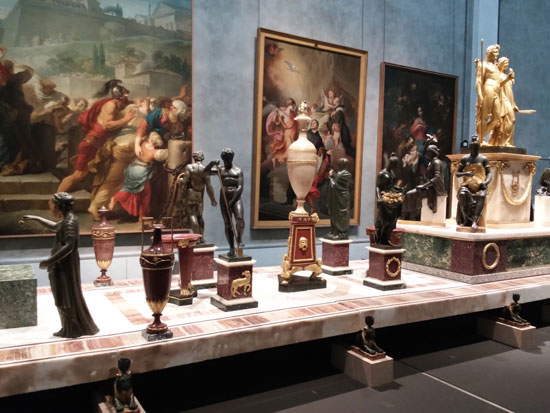 |
| View of one of the two sides |
Warning: the translation into English of the original Italian article was created using automatic tools. We undertake to review all articles, but we do not guarantee the total absence of inaccuracies in the translation due to the program. You can find the original by clicking on the ITA button. If you find any mistake,please contact us.




























